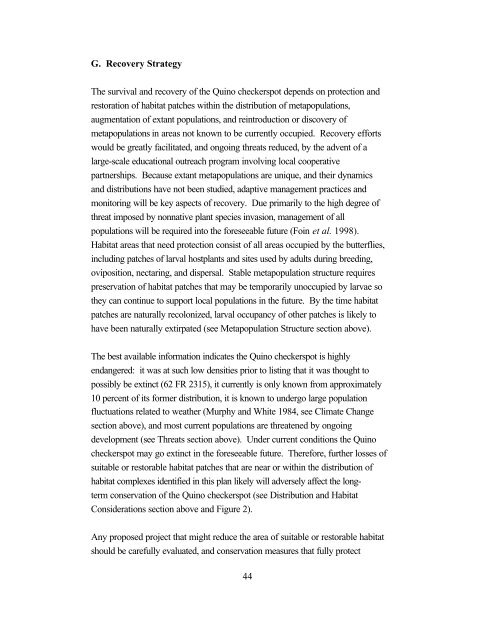Outline of Quino Recovery Plan - The Xerces Society
Outline of Quino Recovery Plan - The Xerces Society
Outline of Quino Recovery Plan - The Xerces Society
Create successful ePaper yourself
Turn your PDF publications into a flip-book with our unique Google optimized e-Paper software.
G. <strong>Recovery</strong> Strategy<br />
<strong>The</strong> survival and recovery <strong>of</strong> the <strong>Quino</strong> checkerspot depends on protection and<br />
restoration <strong>of</strong> habitat patches within the distribution <strong>of</strong> metapopulations,<br />
augmentation <strong>of</strong> extant populations, and reintroduction or discovery <strong>of</strong><br />
metapopulations in areas not known to be currently occupied. <strong>Recovery</strong> efforts<br />
would be greatly facilitated, and ongoing threats reduced, by the advent <strong>of</strong> a<br />
large-scale educational outreach program involving local cooperative<br />
partnerships. Because extant metapopulations are unique, and their dynamics<br />
and distributions have not been studied, adaptive management practices and<br />
monitoring will be key aspects <strong>of</strong> recovery. Due primarily to the high degree <strong>of</strong><br />
threat imposed by nonnative plant species invasion, management <strong>of</strong> all<br />
populations will be required into the foreseeable future (Foin et al. 1998).<br />
Habitat areas that need protection consist <strong>of</strong> all areas occupied by the butterflies,<br />
including patches <strong>of</strong> larval hostplants and sites used by adults during breeding,<br />
oviposition, nectaring, and dispersal. Stable metapopulation structure requires<br />
preservation <strong>of</strong> habitat patches that may be temporarily unoccupied by larvae so<br />
they can continue to support local populations in the future. By the time habitat<br />
patches are naturally recolonized, larval occupancy <strong>of</strong> other patches is likely to<br />
have been naturally extirpated (see Metapopulation Structure section above).<br />
<strong>The</strong> best available information indicates the <strong>Quino</strong> checkerspot is highly<br />
endangered: it was at such low densities prior to listing that it was thought to<br />
possibly be extinct (62 FR 2315), it currently is only known from approximately<br />
10 percent <strong>of</strong> its former distribution, it is known to undergo large population<br />
fluctuations related to weather (Murphy and White 1984, see Climate Change<br />
section above), and most current populations are threatened by ongoing<br />
development (see Threats section above). Under current conditions the <strong>Quino</strong><br />
checkerspot may go extinct in the foreseeable future. <strong>The</strong>refore, further losses <strong>of</strong><br />
suitable or restorable habitat patches that are near or within the distribution <strong>of</strong><br />
habitat complexes identified in this plan likely will adversely affect the longterm<br />
conservation <strong>of</strong> the <strong>Quino</strong> checkerspot (see Distribution and Habitat<br />
Considerations section above and Figure 2).<br />
Any proposed project that might reduce the area <strong>of</strong> suitable or restorable habitat<br />
should be carefully evaluated, and conservation measures that fully protect<br />
44
















